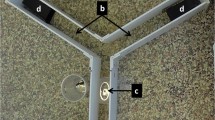Abstract
Burrow construction abilities of laboratory-reared oldfield mice (Peromyscus polionotus), deermice (P. maniculatus), and their F1 hybrids were compared using a spacious earth-filled test chamber. Mated paris with nursing litters were individually introduced into the chamber for 4 days in each test. Oldfield mice bred in metal or plastic cages for 20 or more generations constructed elaborate burrows, with entrance and escape tunnels, tunnel plugs, next chambers, and nests, essentially like those of wild mice of this species. Prairie deermice maintained for 25 or more generations in captivity constructed shallow or superficial burrows characteristic of deermice in nature. F1 hybrids made burrows like those of oldfield mice, complete in all particulars. First-generation backcross animals tested for burrow building exhibited a spectrum of performances. Species difference in burrow construction is principally genetic in origin, and during 20–25 generations in captivity no substantial loss of this ability occurred. F1 hybrid data indicate that the more complex burrow building exhibits genetic dominance, and backcross results show that at least two and probably more gene loci strongly influence the trait.
Similar content being viewed by others
References
Blair, W. F. (1950). Ecological factors in speciation ofPeromyscus.Evolution 4:253–275.
Dawson, W. D. (1965). Fertility and size inheritance in aPeromyscus species cross.Evolution 19:44–55.
DeFries, J. C., and Hegmann, J. P. (1970). Genetic analysis of open-field behavior. In Lindzey, G., and Theissen, D. D. (eds.)Contributions to Behavior Genetic Anlaysis: The Mouse as a Prototype, Appleton-Century-Crofts, New York.
Dice, L. R., Barto, E., and Clark, P. J. (1963). Modifications of behavior associated with inherited convulsions or whirling in three strains ofPeromyscus.Anim. Behav. 11:40–50.
Driscoll, P. (1986). Roman high- and low-avoidance rats: Present status of the Swiss sublines, RHA/Verh and RLA/Verh, and effects of amphetamine on shuttle-box performance.Behav. Genet. 16:355–364.
Eisenberg, J. F. (1963). The intraspecific social behavior of some cricetine rodents of the GenusPeromyscus.Am. Mid. Nat. 69:240–246.
Harrington, G. M. (1981). The Har strains of rats: Origins and characteristics.Behav. Genet. 11:445–468.
Hayne, D. W. (1936). Burrowing habits ofPeromyscus polionotus.J. Mamm. 17:420–421.
Houtcooper, W. C. (1971). Rodent seed supply and burrows ofPeromyscus in cultivated fields.Proc. Ind. Acad. Sci. 81:384–389.
Kavanau, J. L. (1967). Behavior of captive white-footed mice.Science 155:1623–1639.
King, J. A., Price, E. O., and Weber, P. L. (1968). Behavior comparisons within the genusPeromyscus.Papers Mich. Acad. Sci. Arts. Lett. 51:113–136.
Layne, J. N., and Ehrhart, L. M. (1970). Digging behavior of four species of deer mice (Peromyscus).Am. Mus. Novit 2429:1–16.
Mather, K. (1949).Biometric Genetics, Dover, New York.
Reading, A. J. (1966). Effect of the maternal environment on behavior of inbred mice.J. Comp. Physiol. Psychol. 62:437–440.
Schwartz, C. W., and Schwartz, E. R. (1981).The Wild Mammals of Missouri, University of Missouri Press, Columbia.
Scott, J. P., and Fuller, J. L. (1965).Genetics and Social Behavior of the Dog, University of Chicago Press, Chicago.
Sidman, R. L., Appel, S. H., and Fuller, J. L. (1965). Neurological mutants of the mouse.Science 150:513–516.
Smith, M. H., and Criss, W. E. (1967). Effect of social behavior, sex, and ambient temperature on the endogenous diel body temperature cycle of the old field mouse,Peromyscus polionotus.Physiol. Zool. 40:31–39.
Steele, R. G. D., and Torrie, J. H. (1960).Principles and Procedures of Statistics, McGraw-Hill, New York.
Summer, F. B., and Karol, J. J. (1929). Notes of the burrowing habits ofPeromyscus polionotus.J. Mamm. 10:213–215.
van Abeelen, J. H. F. (1977). Rearing responses and locomotor activity in mice: Single locus control.Behav. Biol. 19:401–404.
Webster, D. G., Williams, M. H., Owens, R. D., Geiger, V. B., and Dewsbury, D. A. (1981). Digging behavior in 12 taxa of muroid rodents.Anim. Learn. Behav. 9:173–177.
Whitney, G. D. (1969). Vocalization of mice influenced by a single genetic unit effect.J. Hered. 60:337–340.
Wolfe, J. L., and Esher, R. J. (1977). Burrowing behavior of oldfield mice (Peromyscus polionotus): A laboratory investigation.Biol. Behav. 2:343–351.
Author information
Authors and Affiliations
Rights and permissions
About this article
Cite this article
Dawson, W.D., Lake, C.E. & Schumpert, S.S. Inheritance of burrow building inPeromyscus . Behav Genet 18, 371–382 (1988). https://doi.org/10.1007/BF01260937
Received:
Accepted:
Issue Date:
DOI: https://doi.org/10.1007/BF01260937




